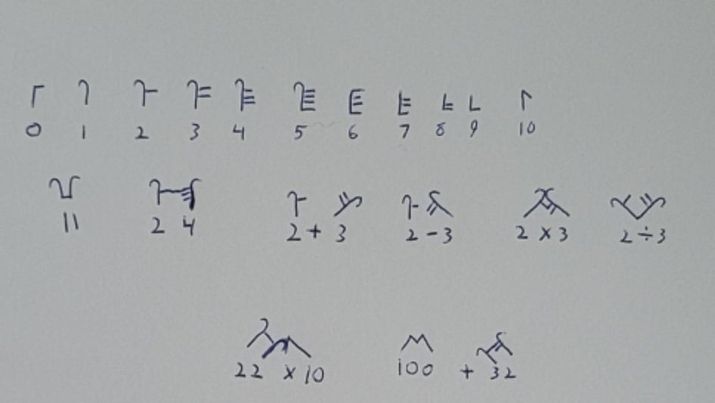The Old Tongue
The Old Tongue is the ancient language of the Grimlocks, progenitors of mankind. The Grimlocks called it HYAGA, which literally means the movement of wisdom. They called the spoken language HYAGAF, the written language HYAGASH, and the gesture language HYAGAHY.
Writing System
The alphabet of the Old Tongue is 60 letters, arranged on two axes: 12 dimensions by 5 states. Each letter has a corresponding gesture on a five fingered hand, with the dimensions represented by the finger position and the states represented by the position of the thumb. Each letter represents a basic concept or idea from which the universe (according to the ancients) was built. Some of these make words that make sense to more modern mankind, many do not.
| Solid | Liquid | Gas | Plasma | Quintessence | |
|---|---|---|---|---|---|
| Matter | Solid (Sh) | Liquid (Cz) | Gas (Suh) | Plasma (Z) | Emptiness (S) |
| Measure | Length (Tch) | Volume (D) | Depth (Th) | Height (Ty) | Time (T) |
| Humors | Black Bile (H'M) | Phlegm (M'M) | Blood (M'N) | Yellow Bile (M'G) | Necrosis (M) |
| Astral | Melancholy (Nia) | Phlegmancy (N'G) | Sanguinity (NG) | Cholerity (GN) | Sleep (N) |
| Mental | Logic (B) | Reason (P) | Speech (F) | Imagination (PF) | Learning (Pi) |
| Unity | Individual (He) | Family (Ha) | Friends (Hr) | Country (Hii) | Contract (H) |
| Spiritual | Wisdom (G) | Alcohol (KK) | Breath (Ka) | Life (Kuh) | Soul (K) |
| Divinity | Theology (LL) | Authority (Al) | Command (HL) | Ideal (La) | Purpose (L) |
| Logoic | Being (RR) | Singular (Ri) | Plurality (Er) | god (Ra) | God (R) |
| Prismatic | Black (Iv) | Blue (Av) | Yellow (W) | Red (Ve) | White (V) |
| Dynamic | Explode (Ya) | Move (Hy) | Expand (Y'g) | Increase (Yd) | Cease (Y) |
| Concordance | Same (iJ) | Agree (uJ) | Align (aJ) | Conflict (Je) | Contrary (Jo) |
Geographical Distribution
Found in the ruins built by ancient man
Morphology
In the Old Tongue, each letter has a basic meaning, altered by the other letters in a word. Depending on the writer, reader, and formality, words may be basic (which are usually shorter words) or complex. Complex words tend to contain detailed description of the concept and leaves little doubt as to the words meaning, while the more informal mode of language tends to be vague-ish and much less precise.
The lettering is based on hand gestures. When communicating by gesture, or supplementing ones' words with gesture, the hand his held with the palm out as the fingers dance through the lettering. Emotion is conveyed from further motions of the hand, the complexities of which have mostly been lost but the basics are that they higher the hands the more positive the emotion. Letters displayed on the left hand are positive and letters displayed on the right hand are meant to convey a reversal of the concept represented by the letter.
Numbering
Just as the letters are based on hand gestures, so are the number forms. The hands are held with the palms to the chest, signifying that the gestures are to convey numbers. Zero, and the beginning of any string of numbers, is represented by a closed fist with the thumb laid on top of the closed fingers. One lifts the thumb up, two extends thumb and forefinger, three adds the middle finger, four adds the ring finger, and five is an open palm towards the chest. Six curls the thumb while keeping the other fingers straight, seven also curls the index finger, eight also curls the middle finger, nine curls all but the pinkie finger, and ten is a closed fist with the thumb tucked inside the fingers. The right hand is used to indicate modifiers. If held in a simple reverse of the left hand, it is meant to convey the 'tens' place. For instance, eleven would be both thumbs in the air while twenty six would be a thumb curled with four extended fingers on the left hand while the other hand displays a raised thumb and extended forefinger. If the right hand is indicating an addition instead, the hand is held at a forty five degree angle upwards while gesturing, and to indicate subtraction it is held at a forty five degree angle down. To indicate multiplication both hands are held with forearms crossed with the right over the left, and division with the left over the right.Syntax
A word is a descriptive entity contained in itself. Sentences are framed as the whole concept, and are usually broken up into smaller sentences when converted to common and contained as a paragraph.
In all of the Old Tongue writings, the end of a sentence is represented by a 'tail' that contains a simple symbol. Conventional wisdom assumes that this is a signature of the scribe. For instance, one of the most common finds are tablets from a scribe that most often talks on military matters and fighting techniques represented by a single-barbed circle. The Archaeologists have dubbed this scribe as "Scorpion Scribe."
Phonetics
The Old Tongue has no explicit vowels, though some letters have implicit vowels attached to them.




Comments